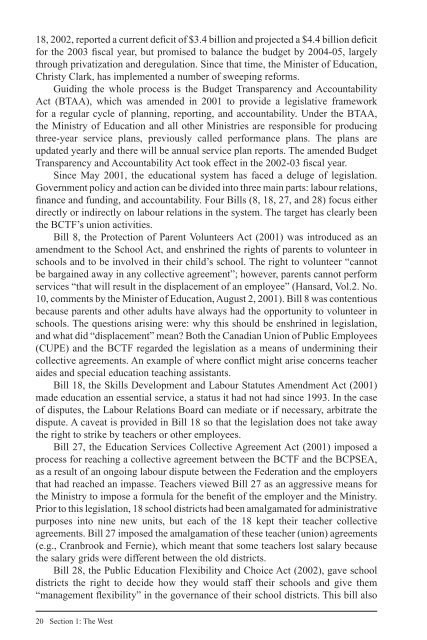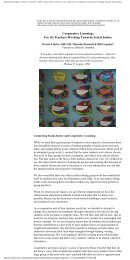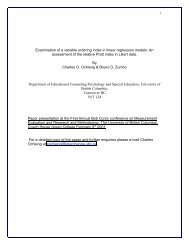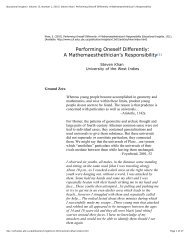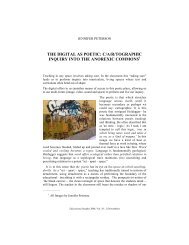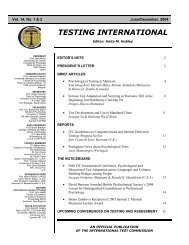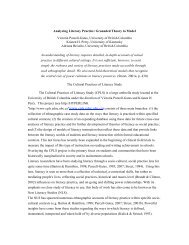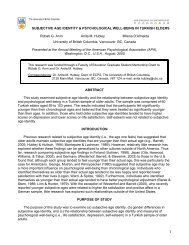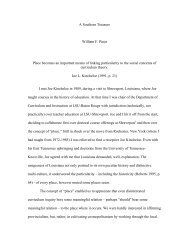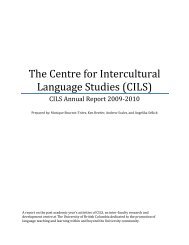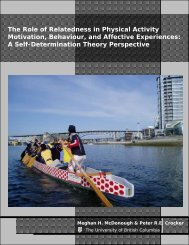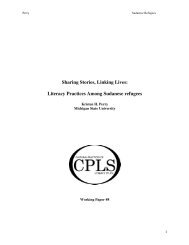The evolution of professionalism - Centre for Policy Studies in ...
The evolution of professionalism - Centre for Policy Studies in ...
The evolution of professionalism - Centre for Policy Studies in ...
You also want an ePaper? Increase the reach of your titles
YUMPU automatically turns print PDFs into web optimized ePapers that Google loves.
18, 2002, reported a current defi cit <strong>of</strong> $3.4 billion and projected a $4.4 billion defi cit<br />
<strong>for</strong> the 2003 fi scal year, but promised to balance the budget by 2004-05, largely<br />
through privatization and deregulation. S<strong>in</strong>ce that time, the M<strong>in</strong>ister <strong>of</strong> Education,<br />
Christy Clark, has implemented a number <strong>of</strong> sweep<strong>in</strong>g re<strong>for</strong>ms.<br />
Guid<strong>in</strong>g the whole process is the Budget Transparency and Accountability<br />
Act (BTAA), which was amended <strong>in</strong> 2001 to provide a legislative framework<br />
<strong>for</strong> a regular cycle <strong>of</strong> plann<strong>in</strong>g, report<strong>in</strong>g, and accountability. Under the BTAA,<br />
the M<strong>in</strong>istry <strong>of</strong> Education and all other M<strong>in</strong>istries are responsible <strong>for</strong> produc<strong>in</strong>g<br />
three-year service plans, previously called per<strong>for</strong>mance plans. <strong>The</strong> plans are<br />
updated yearly and there will be annual service plan reports. <strong>The</strong> amended Budget<br />
Transparency and Accountability Act took effect <strong>in</strong> the 2002-03 fi scal year.<br />
S<strong>in</strong>ce May 2001, the educational system has faced a deluge <strong>of</strong> legislation.<br />
Government policy and action can be divided <strong>in</strong>to three ma<strong>in</strong> parts: labour relations,<br />
fi nance and fund<strong>in</strong>g, and accountability. Four Bills (8, 18, 27, and 28) focus either<br />
directly or <strong>in</strong>directly on labour relations <strong>in</strong> the system. <strong>The</strong> target has clearly been<br />
the BCTF’s union activities.<br />
Bill 8, the Protection <strong>of</strong> Parent Volunteers Act (2001) was <strong>in</strong>troduced as an<br />
amendment to the School Act, and enshr<strong>in</strong>ed the rights <strong>of</strong> parents to volunteer <strong>in</strong><br />
schools and to be <strong>in</strong>volved <strong>in</strong> their child’s school. <strong>The</strong> right to volunteer “cannot<br />
be barga<strong>in</strong>ed away <strong>in</strong> any collective agreement”; however, parents cannot per<strong>for</strong>m<br />
services “that will result <strong>in</strong> the displacement <strong>of</strong> an employee” (Hansard, Vol.2. No.<br />
10, comments by the M<strong>in</strong>ister <strong>of</strong> Education, August 2, 2001). Bill 8 was contentious<br />
because parents and other adults have always had the opportunity to volunteer <strong>in</strong><br />
schools. <strong>The</strong> questions aris<strong>in</strong>g were: why this should be enshr<strong>in</strong>ed <strong>in</strong> legislation,<br />
and what did “displacement” mean? Both the Canadian Union <strong>of</strong> Public Employees<br />
(CUPE) and the BCTF regarded the legislation as a means <strong>of</strong> underm<strong>in</strong><strong>in</strong>g their<br />
collective agreements. An example <strong>of</strong> where confl ict might arise concerns teacher<br />
aides and special education teach<strong>in</strong>g assistants.<br />
Bill 18, the Skills Development and Labour Statutes Amendment Act (2001)<br />
made education an essential service, a status it had not had s<strong>in</strong>ce 1993. In the case<br />
<strong>of</strong> disputes, the Labour Relations Board can mediate or if necessary, arbitrate the<br />
dispute. A caveat is provided <strong>in</strong> Bill 18 so that the legislation does not take away<br />
the right to strike by teachers or other employees.<br />
Bill 27, the Education Services Collective Agreement Act (2001) imposed a<br />
process <strong>for</strong> reach<strong>in</strong>g a collective agreement between the BCTF and the BCPSEA,<br />
as a result <strong>of</strong> an ongo<strong>in</strong>g labour dispute between the Federation and the employers<br />
that had reached an impasse. Teachers viewed Bill 27 as an aggressive means <strong>for</strong><br />
the M<strong>in</strong>istry to impose a <strong>for</strong>mula <strong>for</strong> the benefi t <strong>of</strong> the employer and the M<strong>in</strong>istry.<br />
Prior to this legislation, 18 school districts had been amalgamated <strong>for</strong> adm<strong>in</strong>istrative<br />
purposes <strong>in</strong>to n<strong>in</strong>e new units, but each <strong>of</strong> the 18 kept their teacher collective<br />
agreements. Bill 27 imposed the amalgamation <strong>of</strong> these teacher (union) agreements<br />
(e.g., Cranbrook and Fernie), which meant that some teachers lost salary because<br />
the salary grids were different between the old districts.<br />
Bill 28, the Public Education Flexibility and Choice Act (2002), gave school<br />
districts the right to decide how they would staff their schools and give them<br />
“management fl exibility” <strong>in</strong> the governance <strong>of</strong> their school districts. This bill also<br />
20 Section 1: <strong>The</strong> West


